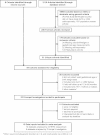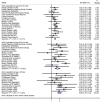Risk of childhood undernutrition related to small-for-gestational age and preterm birth in low- and middle-income countries
- PMID: 23920141
- PMCID: PMC3816349
- DOI: 10.1093/ije/dyt109
Risk of childhood undernutrition related to small-for-gestational age and preterm birth in low- and middle-income countries
Abstract
Background: Low- and middle-income countries continue to experience a large burden of stunting; 148 million children were estimated to be stunted, around 30-40% of all children in 2011. In many of these countries, foetal growth restriction (FGR) is common, as is subsequent growth faltering in the first 2 years. Although there is agreement that stunting involves both prenatal and postnatal growth failure, the extent to which FGR contributes to stunting and other indicators of nutritional status is uncertain.
Methods: Using extant longitudinal birth cohorts (n=19) with data on birthweight, gestational age and child anthropometry (12-60 months), we estimated study-specific and pooled risk estimates of stunting, wasting and underweight by small-for-gestational age (SGA) and preterm birth.
Results: We grouped children according to four combinations of SGA and gestational age: adequate size-for-gestational age (AGA) and preterm; SGA and term; SGA and preterm; and AGA and term (the reference group). Relative to AGA and term, the OR (95% confidence interval) for stunting associated with AGA and preterm, SGA and term, and SGA and preterm was 1.93 (1.71, 2.18), 2.43 (2.22, 2.66) and 4.51 (3.42, 5.93), respectively. A similar magnitude of risk was also observed for wasting and underweight. Low birthweight was associated with 2.5-3.5-fold higher odds of wasting, stunting and underweight. The population attributable risk for overall SGA for outcomes of childhood stunting and wasting was 20% and 30%, respectively.
Conclusions: This analysis estimates that childhood undernutrition may have its origins in the foetal period, suggesting a need to intervene early, ideally during pregnancy, with interventions known to reduce FGR and preterm birth.
Keywords: Foetal growth restriction; childhood; preterm birth; stunting; wasting.
Figures




Comment in
-
Commentary: Foetal growth, preterm birth and childhood undernutrition.Int J Epidemiol. 2013 Oct;42(5):1355-7. doi: 10.1093/ije/dyt165. Epub 2013 Sep 10. Int J Epidemiol. 2013. PMID: 24021913 No abstract available.
References
-
- United Nations Children’s Fund, World Health Organization, World Bank. UNICEF-WHO-World Bank Joint Child Malnutrition Estimates. New York, Geneva, Washington, DC: UNICEF, WHO, World Bank; 2012.
-
- Black RE, Allen LH, Bhutta ZA, et al. Maternal and child undernutrition: global and regional exposures and health consequences. Lancet. 2008;371:243–60. - PubMed
-
- Pelletier DL. The relationship between child anthropometry and mortality in developing countries: implications for policy, programs and future research. J Nutr. 1994;124:S2047–S81. - PubMed
-
- Victora CG, de Onis M, Hallal PC, Blossner M, Shrimpton R. Worldwide timing of growth faltering: revisiting implications for interventions. Pediatrics. 2010;125:e473–80. - PubMed
Publication types
MeSH terms
Grants and funding
LinkOut - more resources
Full Text Sources
Other Literature Sources
Medical
Miscellaneous

